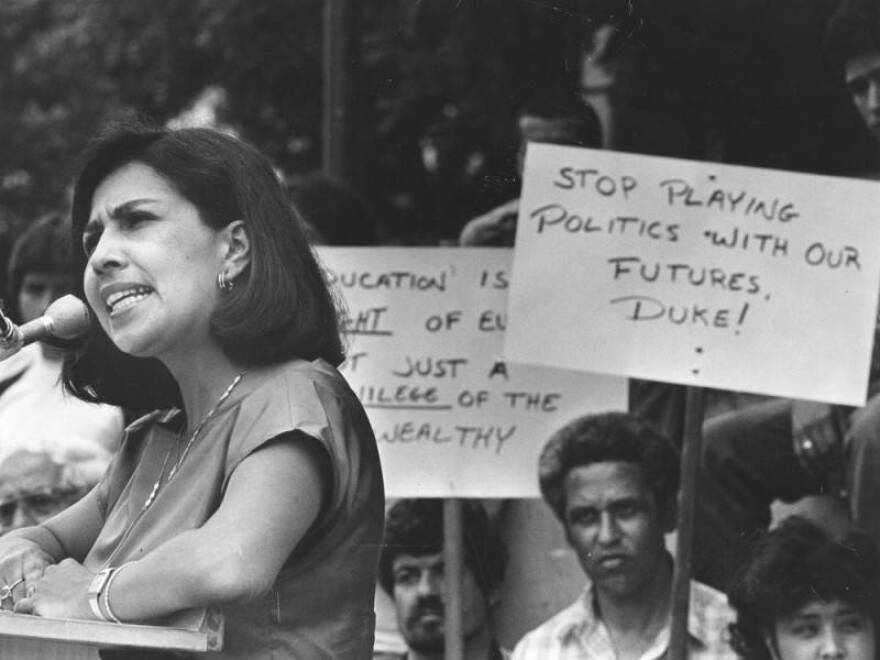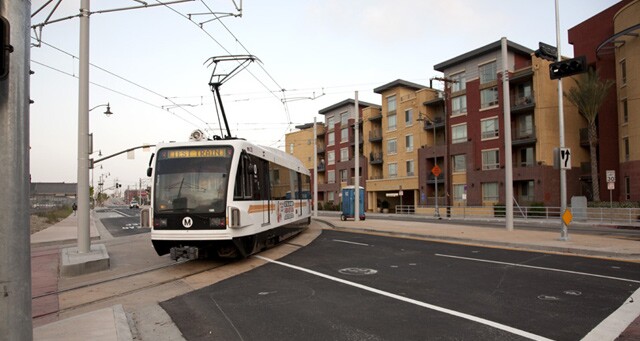Truth matters. Community matters. Your support makes both possible. LAist is one of the few places where news remains independent and free from political and corporate influence. Stand up for truth and for LAist. Make your year-end tax-deductible gift now.
Gloria Molina Has Championed LA's Eastside. Looking Back At Some Of Her Landmark Efforts

Gloria Molina has had a huge impact on life in L.A. County — most notably in the communities on L.A's Eastside where she was born and raised. The pioneering Latina lawmaker announced this week that she has terminal cancer, saying “I enter this transition in life feeling so fortunate.”
The news has many who worked with Molina and followed her long career as an activist and a politician thinking about the legacy she has created.
Molina was “always pushing the Mexican agenda, the Mexican working-class agenda, never forgetting where she came from,” said Antonia Hernández, president and CEO of the California Community Foundation and Molina’s longtime colleague and friend.
We spoke to Hernández and others about what stands out to them about Molina's work.
How Molina's roots guided her career
Where Molina came from is the Eastside: born in Montebello, which borders East Los Angeles, and later raised in Pico Rivera, the first of 10 children of a Mexican mother and Mexican American father. Those close to her say these roots have grounded her, particularly in her service to the communities she has represented.
In her 23 years as a county supervisor, Molina represented the First District, which stretches from downtown and northeast L.A. into the San Gabriel Valley and includes historic Latino working-class hubs like Boyle Heights, El Sereno, East L.A. and Montebello.
Her fight to end forced sterilizations
Hernández met Molina in 1974, about eight years before Molina would become the first Latina elected to the State Assembly. Hernández, an attorney, was at the time seeking a Latina organization to join her in a class action lawsuit against L.A. County-USC Medical Center for carrying out forced sterilizations on Latinas who were delivering their babies at the county hospital.
Back then, Molina was president of a Latina women’s rights group, Comisión Femenil; Hernández asked the group to join.
“If you become a class plaintiff as they did, and you lose a case, you might be liable for, you know, attorney's fees and court fees,” Hernández said. “Gloria had no hesitation.”

Gloria was not only just a woman — [she was] a working-class Chicana coming from a very traditional family that, you know, would speak with a voice that was different.
While the court ruled against the plaintiffs, the case ultimately led to new state policies, including the repeal of a state sterilization law that had led to thousands of unauthorized sterilizations over the years.
As a Mexican American woman from a working-class community, Molina got it, Hernández said — and would continue to do so as a local leader.
“We women have children. We are the mothers. We are the ones that nurture a culture,” Hernández said. “Gloria was not only just a woman — [she was] a working-class Chicana coming from a very traditional family that, you know, would speak with a voice that was different.”
As a representative “of those that had very little power,” Hernández said, Molina championed causes that affected low-income working families and sought ways to improve their quality of life.
Fighting a prison and Exide
In the 1980s, Molina became involved with Mothers of East Los Angeles, a group that successfully fought plans to build a prison in East L.A.
“She knew very early on the detrimental impact of the carceral state, not only on the region, but particularly on the Eastside,” said Sonja Diaz, founding director of the UCLA Latino Policy & Politics Institute, who grew up in Molina’s supervisorial district in El Sereno.
“One of the things about what Gloria represents is she represents Los Angeles, and she represents a part of the region that has been discriminated against — not just politically, but environmentally,” Diaz said, noting that “five freeways cut across East Los Angeles.”
Molina also understood how working-class communities bear the brunt of industrial pollution, said Diaz and others. When it became known that the Exide battery recycling plant in Vernon was contaminating neighboring communities such as Boyle Heights, she led efforts to have the county shut it down.
A push for more hospital beds and transit lines
Molina pushed to get more hospital beds added to the new L.A. County-USC hospital facility in Lincoln Heights, which replaced the old county hospital.
She also saw to it that L.A.'s growing public transportation network made it to the Eastside.
“During the time that she was serving, she helped to push through the East L.A. Gold Line,” said Hilda Solis, who succeeded Molina as First District Supervisor in 2014. “And that was really powerful, because we had no mass transit rail system here in our area … it meant so much for people that were so dependent on bus ridership.”

Other rail lines to the west had been in place for some time, Solis said, but there were none connecting the rest of L.A. to the working-class Latino neighborhoods to the east where many of those bus riders lived.
“So we're talking about equity, you know, really combating racial injustice — because we should all be able to benefit from taxpayer dollars,” Solis said.
As a county supervisor, Molina also worked to elevate Mexican and Mexican American culture, helping create La Plaza de Cultura y Artes, the Mexican American museum and cultural center in downtown L.A. On a quirkier note, she also helped save an iconic roadside architecture structure in East L.A. known as The Tamale building.
Molina won her supervisor seat in 1991 after a voting rights lawsuit by the Mexican American Legal Defense and Educational Fund spurred a federal court to create the Latino-majority First District.
Fernando Guerra, founding director of the Center for the Study of Los Angeles at Loyola Marymount University, said it was during her tenure on the Board of Supervisors that Molina had the most direct influence on local communities.
“Being one out of five, people had to listen to her,” he said. “They had to listen to that authentic community voice, and that's where she really made a difference.”
Editor's note
Fernando Guerra is an honorary lifetime trustee for Southern California Public Radio, which owns and operates LAist.







